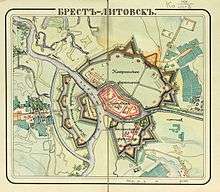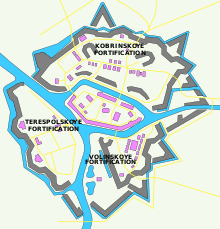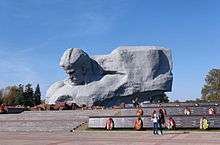Brest Fortress
Brest Fortress (Belarusian: Брэсцкая крэпасць, Bresckaja krepasć; Polish: Twierdza brzeska), formerly known as Brest-Litoŭsk Fortress, is a 19th-century fortress in Brest in present-day Belarus. In 1965 the title "Hero Fortress" was given to the fortress to commemorate the defence of the frontier stronghold during the first week of the German-Soviet War of 1941-1945 when Axis forces invaded the Soviet Union with the launch of Operation Barbarossa on June 22, 1941. The title "Hero Fortress" corresponds to the title "Hero City" that the Presidium of the Supreme Soviet of the Soviet Union awarded to an eventual total of twelve Soviet cities.


Description
The Brest fortress has sustained its original outline of a star shaped fortification since its construction in the early 19th century. The Citadel, the core of the fortress, was on the central island formed by the Bug River and the two branches of the Mukhavets River. The island was skirted by a ring of a two-storied barrack with 4 semi-towers. The 1.8 km long barrack comprised 500 rooms to accommodate 12,000 soldiers within thick walls built from super strong red bricks. Originally there were 4 gates to enter the Citadel. Today only Kholm Gate and Terespol Gate can be seen, most part of the barrack lies in ruins.
The Citadel was surrounded by 3 fortifications as bridgeheads, that were made up by branches of the Mukhavets River and moats (ditches), fortified by earthworks 10 m high with redbrick casemates inside. The 3 fortifications were named after two towns: Russian name for the city of Kobryn in Belarus, Terespol in Poland and Volyn, a historic region of Volhynia majorly located in Ukraine. The Kobrin Fortification was the biggest in the fortress, located in the northeastern part, shaped like a horseshoe, featured 4 fortification curtains, 3 detached ravelins and a lunette in the western part, East Fort and West Fort. The Terespol Fortification was the western bridgehead, featuring 4 detached lunettes. The Volyn Fortification was the southeastern bridgehead, featuring 2 fortification curtains with 2 detached ravelins.[1]
History
Construction
The construction of the Imperial Russian fortress started in 1833 based on draft of the Russian military engineer Karl Opperman in place of the old Ducal Lithuanian Brest Castle.
WWI
After the fall of the forts at Kovno and Novogeorgievsk, the Russians abandoned Brest fortress, carrying away most of the munitions that were stockpiled there. The Germans entered the fort on August 26, 1915. In 1918, the fort was the location of the signing of the Treaty of Brest-Litovsk, which made peace between USSR and the Central Powers.
During WWII
Defence of Brest Fortress
At 04:15 (Moscow time) June 22, 1941 the German Wehrmacht attacked the Brest fortress with no warning. The attack started with an artillery barrage, including 600 mm mortars of the second battery of the Heavy Artillery Battalion 833 Nr. III ("Thor") and Nr. IV ("Odin").[2] The defenders were taken by surprise and initially failed to form a solid front. By 09:00 that day, the fortress was completely surrounded. The ensuing battle of Brest Fortress lasted for 7 days, during which lives lost about 2000 soldiers and officers defending the castle, and attackers losing nearly 430 soldiers and officers.[3][4]
The last defended object in the fortress was taken by June 29. About 6,800 Soviet soldiers and commanders were captured.
According to Soviet sources, the battle lasted until 20 July, with no one surrendering to the Germans. This narrative became a testament to the resilience and courage of Red Army and Soviet people.[5] A few Soviet soldiers did indeed hold out inside pockets of the fortress until as late as 23 July.
Legacy
War Memorial Complex

In the late 1960s, the construction of the war memorial complex "Brest Hero Fortress" was started. The complex was opened on September 25, 1971.[6] The memorial complex is a national place of grief and pride, a popular tourist attraction. It comprises the barracks, gunpowder bunkers, forts and other fortifications, the museum of the defence, located on the site of the old fortress, along with the new monumental structures: the Main Entrance, the Obelisk, the Main Monument, the sculpture "Thirst".
World Heritage status
This site was added to the UNESCO World Heritage Tentative List on January 30, 2004, in the Cultural category.[7] Preservation and development is being carried out by the Brest Fortress Development Foundation.[8][9]
Symbol of Brest city
The Brest Fortress is used as a symbol of the Belarussian city of Brest.
Brest in literature and popular culture
- Fortress of War (Russian: Брестская крепость), a 2010 Russian-Belarusian film
- Weary Sun Triumph Brest Fortress (Russian: Утомленное солнце Триумф Брестской крепости), a 2010 alternative history by Valeriy Belousov
- I, a Russian soldier (Russian: Я — русский солдат), a 1995 movie based on the novel His Name is Not in the List
- His Name is Not in the List (Russian: В списках не значился) novel by Boris Vasilyev)
See also
- Defense of Brest Fortress (1941)
- Battle of Brześć Litewski (1939)
References
- Суворов А.М. "Брестская крепость на ветрах истории", Brest, 2004 (text in Russian) ISBN 985-90040-1-3
- "Мортира КАРЛ". Archived from the original on 2017-07-06. Retrieved 2017-05-11.
- Christian Ganzer: German and Soviet Losses as an Indicator of the Length and Intensity of the Battle for the Brest Fortress (1941). In: The Journal of Slavic Military Studies, Volume 27, Issue 3, pp. 449–466, here: p. 463.
- Christian Ganzer: German and Soviet Losses as an Indicator of the Length and Intensity of the Battle for the Brest Fortress (1941). In: The Journal of Slavic Military Studies, Volume 27, Issue 3, pp. 449–466, here: p. 458.
- Christian Ganzer: Soviet Prisoners of war in Soviet and post-Soviet commemorative culture. The Brest fortress: a case study. In: Frédéric Bonnesoeur et al. (eds.): Occupation - Annihilation - Forced Labour. Papers from the 20th Workshop on the History and Memory of National Socialist Concentration Camps. Berlin 2017, pp. 193-209.
- "the official website of the war memorial". Archived from the original on 2017-07-03. Retrieved 2016-05-15.
- UNESCO Tentative List for Belarus
- Brest Heritage
- Brest Fortress Development Foundation to receive US Grant
External links
| Wikimedia Commons has media related to Brest Fortress. |
- Official homepage of the Brest Hero-Fortress Memorial
- Brest Fortress on official website of the Republic of Belarus
- UNESCO publication about the Brest Fortress
- Aerial photo from June, 1940
- Jurkau kutoczak — Юркаў куточак — Yury's Corner. Фартэцыя ў Берасьці 1836-1842 гг.
- Photo 1024x768
- Main fortress 52.082961°N 23.654251°E
- External forts